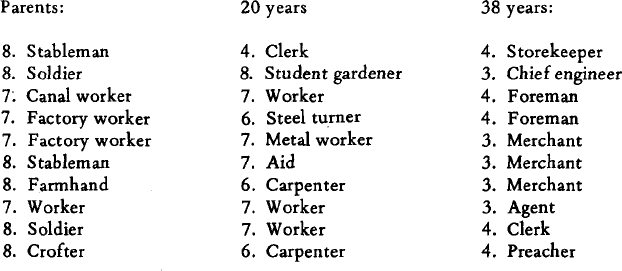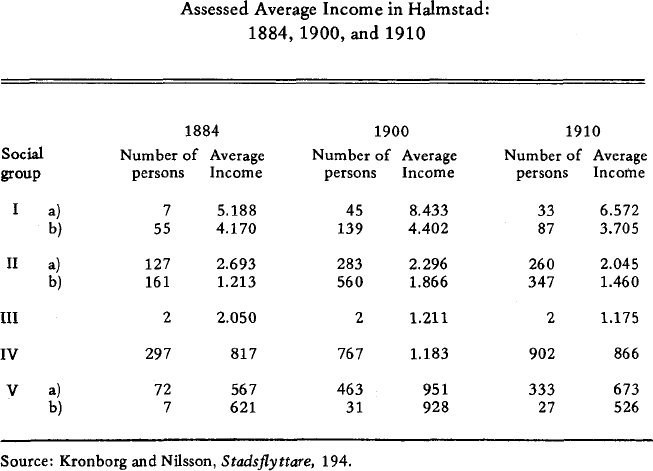Published online by Cambridge University Press: 04 January 2016
Migration, social mobility, and social change are questions that have aroused animated international research debate during recent years. Throughout this discussion, migration often is found to be the triggering mechanism for upward social mobility and social change in the life cycle of individuals. The connection between long-distance migration and social progress in an expanding labor market is thus an important one. In American investigations, a significant amount of social mobility, both upward and downward, has been registered between roughly defined strata in the society. With a corresponding social structure in three Swedish cities investigated in the so-called “Three City Study,” almost the same results are evident.
An earlier, extended form of this article by Margaretha Eriksson and Sune Akerman appeared under the title “Geografisk och social Rörlighet. Resultat frân Trestads-Studien” in Scandia: Tidskrift for historisk forskning, Band 40, Argang 1974, Hafte 2, 260-310.
1 An excellent presentation of the demographic source material can be found in Thomas, Dorothy Swaine, Social and Economic Aspects of Swedish Population Movements, 1750-1933 (New York, 1941), 205-207Google Scholar. The basic features of the registration system were the following: Every resident of Sweden was required to be registered at any given time in only one community, residence being determined by fixed regulations and rules which gave the individual a certain degree of freedom of choice. The pastors of the State Church in their function as civil servants were responsible for keeping the registers of households—the so-called community or parish books—which were checked every year by a canvass and revised after each decennial census. For each member the following details, among many others, were given: Family name and given names, sex, family status, birth place and birth date, civil status, religious affiliations, nationality and citizenship, occupation, address in community, and place of previous residence if an in-migrant from another Swedish community or an immigrant from a foreign country. Changes affecting the status of a resident were recorded as they occurred, or more precisely, at the time they were reported. All changes affecting the size of the population were always recorded in separate books before appropriate entries or changes were made in the community book. These are the book of births, the book of deaths, the book of in-migrants, and the book of out-migrants. In the first two books, births to resident mothers and deaths among residents were recorded, but notes were made of other births and deaths occurring in the community as well. People who presented migration certificates from other Swedish communities (in-migrants) or who arrived from foreign countries (immigrants) with the intention of becoming residents were recorded in the third book. And in the fourth, residents who took out a migration certificate and subsequently departed from the community (out-migrants and emigrants) were listed. An out-migrant was, however, not considered such until confirmation was received from his declared destination that he had taken up residence there. This migration certificate was a transcript from the community book which every Swedish resident was required to take out and present whenever he changed residence.
2 Although this percentage loss is moderate, some degree of bias is introduced, inasmuch as the entire loss consists of migrants. On the other hand, there is little reason to suspect that these missing migrants diverge in some definitive respect from other mobile individuals. What has essentially happened is that the sensitive exchange of information between the delivering and receiving parish in an instance of migration did not always function perfectly.
3 Norman, Hans, Från Bergslagen till Nordamerika: Studier i Migrationsmönster, Social Rörlighet och Demografisk Struktur med Utgångspunkt från Öreboro Län, 1851-1915 [From Bergslagen to North America: Studies in Migration Patterns, Social Mobility, and Demographic Structure on the Basis of Oreboro County, 1851-1915] (Stockholm, 1974)Google Scholar; Kronborg, Bo, and Nilsson, Thomas, Stadsflyttare: Industrialisering, Migration och Social Mobilitet med Utgångspunkt från Halmstad, 1870-1910 [Urban Migrants: Industrialization, Migration, and Social Mobility on the Basis of Halmstad, 1870-1910 (Uppsala, 1975).Google Scholar
4 For a more detailed presentation of this occupational grouping see Norman, H., Från Bergslagen till Nordamerika, 310, 325-330Google Scholar. This crucial movement from the blue-collar to the white-collar level is of utmost importance for the significance of our interpretations. In order to illustrate the accuracy of our judgements the first ten cases that we came across in our material are here listed:
The Västerås cohort:

5 The comparison between tax assessment and social level gave the following result:
Assessed Average Income in Halmstad: 1884,1900, and 1910

Regarding the complications involved in using occupations to determine social status, see Katz, Michael, “Occupational Classification in History,” Journal of Interdisciplinary History, 3 (1972), 63-88CrossRefGoogle Scholar; Laurie, B., Herschberg, T., and Alter, G., “Immigrants and Industry: The Philadelphia Experience,” Second revision presented to the Sixth International Congress in Economic History, Copenhagen, August 19-23, 1974Google Scholar.
6 Carlsson, Gösta, Social Mobility and Class Structure (Lund, 1958), 101Google Scholar. The three-city study as well as other attempts with this new longitudinal approach to social history have not been discussed heretofore, except for Rolf Torstendahl’s laconic criticism in his recent book, Dispersion of Engineers in a Transitional. Society: Swedish Technicians, 1860-1940 (Uppsala, 1975), 286. Torstendahl argued that changes of value systems, from a “traditional” to a “capitalistic mind” should have been more observed. But he offers no solution to the very difficult problem of how to register attitudes in a historical context.
7 Compare Knights, Peter B., “Internal Migration: Native-Born Bostonians in the late 19th Century,” Report to the Convention of the Organization of American Historians in Denver, Colorado, 1974Google Scholar, unpublished paper.
8 It is an important task to isolate social mobility caused by structural changes in society, from social mobility as a consequence of the ambitions of the individuals. The occupational structure of Halmstad shows that it is impossible to argue that the structural changes alone have been the reason for social circulation. A substantial part of the movements must have been caused by the aspirations of the individuals.
Halmstad: Total Population in Social Groups

9 Thernstrom, Stephan, The Other Bostonians: Poverty and Progress in the American Metropolis, 1880-1970 (Cambridge, Massachusetts, 1973), 243, 245.CrossRefGoogle Scholar
10 These findings are based on my forthcoming (1977) book, Swedish and Scandinavian Population Mobility.
11 Carlsson, Social Mobility, 169.